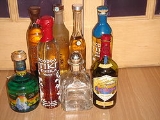
Tequila
Encyclopedia
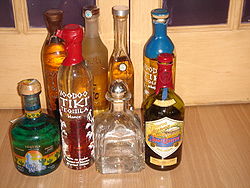
Distilled beverage
A distilled beverage, liquor, or spirit is an alcoholic beverage containing ethanol that is produced by distilling ethanol produced by means of fermenting grain, fruit, or vegetables...
made from the blue agave plant, primarily in the area surrounding the city of Tequila
Tequila, Jalisco
Santiago de Tequila is a town and municipality located in the state of Jalisco about 60 km from the city of Guadalajara. Tequila is best known as being the birthplace of the drink that bears its name, “tequila,” which is made from the blue agave plant, native to this area. The heart of the...
, 65 kilometres (40.4 mi) northwest of Guadalajara
Guadalajara, Jalisco
Guadalajara is the capital of the Mexican state of Jalisco, and the seat of the municipality of Guadalajara. The city is located in the central region of Jalisco in the western-pacific area of Mexico. With a population of 1,564,514 it is Mexico's second most populous municipality...
, and in the highlands (Los Altos) of the western Mexican state of Jalisco
Jalisco
Jalisco officially Estado Libre y Soberano de Jalisco is one of the 31 states which, with the Federal District, comprise the 32 Federal Entities of Mexico. It is located in Western Mexico and divided in 125 municipalities and its capital city is Guadalajara.It is one of the more important states...
.
The red volcanic
Volcano
2. Bedrock3. Conduit 4. Base5. Sill6. Dike7. Layers of ash emitted by the volcano8. Flank| 9. Layers of lava emitted by the volcano10. Throat11. Parasitic cone12. Lava flow13. Vent14. Crater15...
soil in the surrounding region is particularly well suited to the growing of the blue agave, and more than 300 million of the plants are harvested there each year. Agave tequila grows differently depending on the region. Blue agaves grown in the highlands region are larger in size and sweeter in aroma and taste. Agaves harvested in the lowlands, on the other hand, have a more herbaceous fragrance and flavor.
Mexican laws state that tequila can be produced only in the state of Jalisco and limited regions in the states of Guanajuato
Guanajuato
Guanajuato officially Estado Libre y Soberano de Guanajuato is one of the 31 states which, with the Federal District, comprise the 32 Federal Entities of Mexico. It is divided in 46 municipalities and its capital city is Guanajuato....
, Michoacán
Michoacán
Michoacán officially Estado Libre y Soberano de Michoacán de Ocampo is one of the 31 states which, with the Federal District, comprise the 32 Federal Entities of Mexico. It is divided in 113 municipalities and its capital city is Morelia...
, Nayarit
Nayarit
Nayarit officially Estado Libre y Soberano de Nayarit is one of the 31 states which, with the Federal District, comprise the 32 Federal Entities of Mexico. It is divided in 20 municipalities and its capital city is Tepic.It is located in Western Mexico...
, and Tamaulipas
Tamaulipas
Tamaulipas officially Estado Libre y Soberano de Tamaulipas is one of the 31 states which, with the Federal District, comprise the 32 Federal Entities of Mexico. It is divided in 43 municipalities and its capital city is Ciudad Victoria. The capital city was named after Guadalupe Victoria, the...
. Mexico has claimed the exclusive international right to the word "tequila", threatening legal actions against manufacturers of distilled blue agave spirits in other countries.
Tequila is most often made at a 38–40% alcohol content (76–80 proof
Proof (alcohol)
Alcohol proof is a measure of how much alcohol is contained in an alcoholic beverage. The term was originally used in the United Kingdom and was defined as 7/4 times the alcohol by volume . The UK now uses the abv standard instead of alcohol proof. In the United States, alcoholic proof is defined...
), but can be produced between 35–55% alcohol content (70–110 proof). Though most tequilas are 80 proof, many distillers will distill to 100 proof and then dilute it with water to reduce its harshness. Some of the more well respected brands distill the alcohol to 80 proof without using additional water as a dilutant.
History
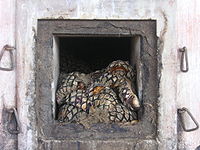
Aztec
The Aztec people were certain ethnic groups of central Mexico, particularly those groups who spoke the Nahuatl language and who dominated large parts of Mesoamerica in the 14th, 15th and 16th centuries, a period referred to as the late post-classic period in Mesoamerican chronology.Aztec is the...
people had previously made a fermented beverage from the agave
Agave
Agave is a genus of monocots. The plants are perennial, but each rosette flowers once and then dies ; they are commonly known as the century plant....
plant, which they called octli (later, and more popularly called pulque
Pulque
Pulque, or octli, is a milk-colored, somewhat viscous alcoholic beverage made from the fermented sap of the maguey plant, and is a traditional native beverage of Mexico. The drink’s history extends far back into the Mesoamerican period, when it was considered sacred, and its use was limited to...
), long before the Spanish
Spain
Spain , officially the Kingdom of Spain languages]] under the European Charter for Regional or Minority Languages. In each of these, Spain's official name is as follows:;;;;;;), is a country and member state of the European Union located in southwestern Europe on the Iberian Peninsula...
arrived in 1521. When the Spanish conquistadors ran out of their own brandy
Brandy
Brandy is a spirit produced by distilling wine. Brandy generally contains 35%–60% alcohol by volume and is typically taken as an after-dinner drink...
, they began to distill agave to produce North America
North America
North America is a continent wholly within the Northern Hemisphere and almost wholly within the Western Hemisphere. It is also considered a northern subcontinent of the Americas...
's first indigenous distilled spirit.
Some 80 years later, around 1600, Don Pedro Sánchez de Tagle, the Marquis of Altamira, began mass-producing tequila at the first factory in the territory of modern-day Jalisco. By 1608, the colonial governor of Nueva Galicia
Nueva Galicia
El Nuevo Reino de Galicia or Nueva Galicia was an autonomous kingdom of the Viceroyalty of New Spain. It was named after Galicia in Spain...
had begun to tax his products. Spain's King Carlos IV granted the Cuervo family the first license to commercially make tequila.
The tequila that is popular today was first mass-produced in the early 19th century in Guadalajara, Mexico.
Don Cenobio Sauza
Don Cenobio Sauza
Don Cenobio Sauza , known as the "Father of Tequila," was one of the earliest and longest lasting distillers of the tequila spirit – founding the Sauza Tequila distillery – La Perseverancia – in 1873....
, founder of Sauza Tequila
Sauza Tequila
Sauza Tequila Import Company is a producer of tequila located in Tequila, a municipality of the state of Jalisco, Mexico. It was founded in 1873 when Don Cenobio Sauza started La Perseverancia distillery. Sauza Tequila Import Company is owned by Beam Inc., headquartered in the Chicago suburb...
and Municipal President of the Village of Tequila from 1884–1885, was the first to export tequila to the United States, and shortened the name from "Tequila Extract" to just "Tequila" for the American markets. Don Cenobio's grandson Don Francisco Javier
Don Francisco Javier Sauza
Don Francisco Javier Sauza ran the Sauza Tequila business from 1946 until leading Mexican brandy producer Pedro Domecq purchased it in 1988.- Early life :...
gained international attention for insisting that "there cannot be tequila where there are no agaves!" His efforts led to the practice that real tequila can come only from the State of Jalisco.
Recent history
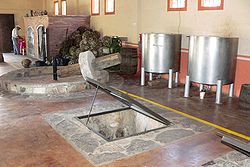
- The purchase of Herradura by Brown-Forman for $776 million in September 2006.
- A new NOM (Norma Oficial Mexicana) for tequila (NOM-006-SCFI-2005) was issued in 2006, and among other changes, introduced a category of tequila called "extra añejo" or "ultra-aged" which must be aged a minimum of 3 years.
- The purchase of the SauzaSauza TequilaSauza Tequila Import Company is a producer of tequila located in Tequila, a municipality of the state of Jalisco, Mexico. It was founded in 1873 when Don Cenobio Sauza started La Perseverancia distillery. Sauza Tequila Import Company is owned by Beam Inc., headquartered in the Chicago suburb...
and El TesoroEl Tesoro tequilaEl Tesoro is a brand of tequila produced at a distillery in Jalisco, Mexico, where the family that founded the distillery is still involved in the business. In the United States, the brand is marketed by Beam Inc....
brands by massive holding company Fortune BrandsFortune BrandsFortune Brands was a holding company founded in 1969 as American Brands and later renamed in 1997 and split apart in 2011. The corporate headquarters was in Deerfield, Illinois in the United States. The company historically had a significant diversity of product offerings...
.
Although some tequilas have remained as family owned brands, most well-known tequila brands are owned by large multinational corporations. However, there are over 100 distilleries making over nine hundred brands of tequila in Mexico and over 2,000 brand names have been registered (2009 Statistics). Due to this, each bottle of tequila contains a serial number (NOM) depicting in which distillery the tequila was produced. Because there are only so many distilleries, multiple brands of tequila come from the same location.
The Tequila Regulatory Council of Mexico originally did not permit flavored tequila to carry the tequila name. In 2004, the Council decided to allow flavored tequila to be called tequila, with the exception of pure agave tequila, which still could not be flavored.
A one-liter bottle of limited-edition premium tequila was sold for $225,000 in July 2006 in Tequila, Jalisco, by the company Tequila Ley .925. The bottle which contains the tequila is a two-kilo display of platinum and gold. The manufacturer has received the Certificate from Guinness World Records
Guinness World Records
Guinness World Records, known until 2000 as The Guinness Book of Records , is a reference book published annually, containing a collection of world records, both human achievements and the extremes of the natural world...
for the most expensive bottle of spirit ever sold.
In 2009, Mexican scientists discovered a method to produce tiny, nanometric size, synthetic diamond
Synthetic diamond
Synthetic diamond is diamond produced in a technological process; as opposed to natural diamond, which is created in geological processes. Synthetic diamond is also widely known as HPHT diamond or CVD diamond, denoting the production method, High-Pressure High-Temperature synthesis and Chemical...
s from 80-proof (40% alcohol) tequila. This process involves heating the tequila to over 800 degrees C (1,400 degrees F) to break its molecular structure and be vaporised. The tequila particles are then settled upon steel or silicon trays to form a thin and pure uniform layer. Extremely cheap to produce and far too small for jewels, the results are hoped to have numerous commercial and industrial applications such as in computer chips or cutting instruments.
2006 Tequila Trade Agreement
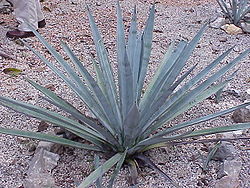
International trade
International trade is the exchange of capital, goods, and services across international borders or territories. In most countries, such trade represents a significant share of gross domestic product...
agreements and was in discord with usual exporting practices worldwide. The proposal might have resulted in the loss of jobs at plants in California, Arkansas, Missouri, and Kentucky, because Mexican tequila exported in bulk to the United States is bottled in those plants. On January 17, 2006, the United States and Mexico signed an agreement allowing the continued bulk import of tequila into the United States. The agreement also created a "tequila bottlers registry" to identify approved bottlers of tequila and created an agency to monitor the registry.
NOM
The NOMNorma Oficial Mexicana
The Norma Oficial Mexicana is the name of each of a series of official, compulsory standards and regulations for diverse activities in Mexico. They are more commonly referred to as NOM or normas.-Tequila:...
applies to all processes and activities related to the supply of agave, production, bottling, marketing, information and business practices linked to the distilled alcoholic beverage
Distilled beverage
A distilled beverage, liquor, or spirit is an alcoholic beverage containing ethanol that is produced by distilling ethanol produced by means of fermenting grain, fruit, or vegetables...
known as Tequila. Tequila must be produced using Agave of the species Tequilana Weber Blue variety, grown in the federal states and municipalities indicated in the Declaration.
Furthermore, the NOM establishes the technical specifications and legal requirements for the protection of the Appellation of Origin of "Tequila," in accordance with the current General Declaration of Protection of the Appellation of Origin of "Tequila," the Law, the Industrial Property Law, the Federal Consumer Protection Law and other related legal provisions.
All authentic, regulated Tequilas will have a NOM identifier on the bottle. The important laws since 1990 were NOM-006-SCFI-1993 and the later update NOM-006-SCFI-1994 and the most recent revision in late 2005, NOM-006-SCFI-2005.
The number after NOM is the distillery number, assigned by the government. NOM does not indicate the location of the distillery, merely the parent company or—in the case where a company leases space in a plant—the physical plant where the tequila was manufactured.
TMA
- For more detail on TMA, see the entry in Agave tequilana
TMA ("tristeza y muerte de agave") is a blight
Blight
Blight refers to a specific symptom affecting plants in response to infection by a pathogenic organism. It is simply a rapid and complete chlorosis, browning, then death of plant tissues such as leaves, branches, twigs, or floral organs. Accordingly, many diseases that primarily exhibit this...
that has reduced the production of the agave grown to produce tequila. This has resulted in lower production and higher prices throughout the early 21st century, and due to the long maturation of the plant, will likely continue to affect prices for years to come.
Production
.png)
They are then shredded and their juices pressed out and put into fermentation tanks and vats. Some tequila companies still use the traditional method (artisanal) in which the piñas are crushed with a tahona (stone wheel). The masquow, (agave juice, and sometimes fiber) is then allowed to ferment in either wood or stainless steel vats for several days to convert the sugars into alcohol. Each company keeps its own yeast a closely guarded secret.
The fermented product is then distilled once to produce what is called "ordinario", a cloudy or milky liquid, and then distilled for a second time to produce a clear, silver tequila. Some distilleries, such as Casa Noble
Casa Noble
Casa Noble is a brand of premium 100% blue agave tequila produced by the Casa Noble Tequila Company, one of only three Organic tequilas made in the world. Casa Noble is distributed in the United States and Canada by Wilson Daniels, Ltd. also known as Infinium Spirits...
, distill the product again to produce a triple distilled product. However, some tequila experts consider triple distilling of tequila flawed and believe that it removes too many flavor elements from the liquid. From there the Tequila is diluted and bottled as a "silver Tequila", or it is pumped into barrels to begin the aging process.
Usually, there is a clear difference in taste between tequila that is made from lowland and highland agave plants. Agave plants that are grown in the highlands often have more sweet fruit flavor, but also more vegetal notes due to the growing process. The distinction has become blurred recently due to the agave shortage that arose in 1999-2000. Since then, many of the larger lowland producers have rented property in the highlands and relied on agave from both areas to produce their tequila.
Most agave plants are grown on west-facing slopes, allowing them to receive the most sunlight throughout the day. These plants are taller, wider, and juicier. Agave grown in the lowlands have more earthy, fiberish flavors, and are typically on the smaller side.
Types
There are two basic categories of tequila: mixtos and 100% agave. Mixtos use no less than 51% agave, with other sugars making up the remainder. Mixtos use both glucose and fructoseFructose
Fructose, or fruit sugar, is a simple monosaccharide found in many plants. It is one of the three dietary monosaccharides, along with glucose and galactose, that are absorbed directly into the bloodstream during digestion. Fructose was discovered by French chemist Augustin-Pierre Dubrunfaut in 1847...
sugars.
With 100% agave tequila, blanco or plata is harsher with the bold flavors of the distilled agave up front, while reposado and añejo are smoother, subtler, and more complex. As with other spirits that are aged in casks, tequila takes on the flavors of the wood, while the harshness of the alcohol mellows. The major flavor distinction with 100% agave tequila is the base ingredient, which is more vegetal than grain spirits (and often more complex).
Tequila is usually bottled in one of five categories:
- Blanco ("white") or plata ("silver"): white spirit, un-aged and bottled or stored immediately after distillation, or aged less than two months in stainless steel or neutral oak barrels;
- Joven ("young") or oro ("gold"): a mixture of blanco tequila and reposado tequila;
- Reposado ("rested"): aged a minimum of two months, but less than a year in oak barrels of any size;
- Añejo ("aged" or "vintage"): aged a minimum of one year, but less than three years in small oak barrels;
- Extra Añejo ("extra aged" or "ultra aged"): aged a minimum of three years in oak barrels. This category was established in March 2006.
Aging process
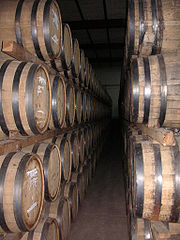
Añejos are often rested in barrels that have been previously used to rest reposados. The barrels cannot be more than 600 liters, and most are in the 200-liter range. Many of the barrels used are from whiskey or bourbon distilleries in America, France, or Canada, and Jack Daniels barrels are especially popular. This treatment creates many of the aspects of the dark color and more complex flavors of the añejo tequila. After aging of at least one year, the añejo can be removed from the wood barrels and placed in stainless steel tanks to reduce the amount of evaporation that can occur in the barrels.
"Tequila worm" myth
It is a misconception that some tequilas contain a "worm" in the bottle. Only certain mezcalMezcal
Mezcal, or mescal, is a distilled alcoholic beverage made from the maguey plant native to Mexico. The word mezcal comes from Nahuatl metl and ixcalli which mean 'oven cooked agave.'...
s, usually from the state of Oaxaca
Oaxaca
Oaxaca , , officially Estado Libre y Soberano de Oaxaca is one of the 31 states which, along with the Federal District, comprise the 32 federative entities of Mexico. It is divided into 571 municipalities; of which 418 are governed by the system of customs and traditions...
, are ever sold con gusano, and that only began as a marketing gimmick in the 1940s. The worm is actually the larval form of the moth Hypopta agavis
Hypopta agavis
Hypopta agavis, whose larvae are known in Spanish as chilocuil, chinicuil, or tecol , is a moth native to North America. Its larvae feed on the succulent leaves of the maguey, although they are not considered a plague, as they have been traditionally used as food in Mexican cuisine...
, which lives on the agave plant. Finding one in the plant during processing indicates an infestation and, correspondingly, a lower quality product. However, this misconception continues, and even with all the effort and marketing to represent tequila as a premium liquor—similar to the way Cognac
Cognac (drink)
Cognac , named after the town of Cognac in France, is a variety of brandy. It is produced in the wine-growing region surrounding the town from which it takes its name, in the French Departements of Charente and Charente-Maritime....
is viewed in relation to other brandies—there are some opportunist producers for the shooters-and-fun market who blur these boundaries.
Brands
There are many brands of tequila; the Consejo Regulador del Tequila (Tequila Regulatory Council) reported 901 registered brands from 128 producers for the year 2008.Ways to drink
In Mexico, the most traditional way to drink tequila is straight (i.e., without lime and salt). It is popular in some regions to drink fine tequila with a side of sangritaSangrita
Sangrita, whose origin dates back to the 1920s, is a customary partner to a shot of straight tequila blanco; a non-alcoholic accompaniment that highlights tequila's crisp acidity and cleanses the palate between each peppery sip. The basic conception of sangrita is to complement the flavor of 100%...
—-a sweet, sour and spicy drink typically made from orange juice, grenadine
Grenadine
Grenadine is traditionally a red syrup. It is used as an ingredient in cocktails, both for its flavor and to give a reddish/pink tinge to mixed drinks. "Grenadines" are also made by mixing the syrup with cold water in a glass or pitcher, sometimes with ice....
(or tomato juice), and hot chillies. Equal-sized shots of tequila and sangrita are sipped alternately, without salt or lime. Another popular drink in Mexico is the "bandera" (Flag, in Spanish), named after the Flag of Mexico
Flag of Mexico
The flag of Mexico is a vertical tricolor of green, white, and red with the national coat of arms charged in the center of the white stripe. While the meaning of the colors has changed over time, these three colors were adopted by Mexico following independence from Spain during the country's War...
, it consists of three shot glasses, filled with lime juice (for the green), white tequila, and sangrita (for the red). They can be sipped or drunk straight.
Outside Mexico, a single shot
Shot glass
A shot glass is a small glass designed to hold or measure spirits or liquor, which is either drunk straight from the glass or poured into a mixed drink....
of tequila is often served with salt
Edible salt
Salt, also known as table salt, or rock salt, is a mineral that is composed primarily of sodium chloride , a chemical compound belonging to the larger class of ionic salts. It is essential for animal life in small quantities, but is harmful to animals and plants in excess...
and a slice of lime. This is called "tequila cruda" and is sometimes referred to as "training wheels", "lick-sip-suck", or "lick-shoot-suck" (referring to the way in which the combination of ingredients is imbibed). The drinker moistens the back of their hand below the index finger (usually by licking) and pours on the salt. Then the salt is licked off the hand, the tequila is drunk, and the fruit slice is quickly bitten. Groups of drinkers often do this simultaneously. Drinking tequila in this way is often erroneously called a Tequila Slammer
Tequila Slammer
The Tequila Slammer is a cocktail served in a rocks glass...
, which is in fact a mix of tequila and carbonated drink. Though the traditional Mexican shot is straight tequila, lime is the fruit of choice when a chaser must be used. It is believed that the salt lessens the "burn" of the tequila and the sour fruit balances and enhances the flavor. In Germany and some other countries, tequila oro (gold) is often consumed with cinnamon
Cinnamon
Cinnamon is a spice obtained from the inner bark of several trees from the genus Cinnamomum that is used in both sweet and savoury foods...
on a slice of orange after, while tequila blanco (white) is consumed with salt and lime. Finally, as with other popular liquors, there exist a number of shot-related drinking games and "stunt" drinks such as body shots.
If the bottle of tequila does not state on the label that it is manufactured from 100% blue agave (no sugars added), then, by default, that tequila is a mixto (manufactured from 51% blue agave). Some tequila distilleries label their tequila as "made with blue agave" or "made from blue agave." However, the Tequila Regulatory Council has stated that only tequilas distilled with 100% agave can be designated as "100% agave."
Some distillers of lower-quality tequila have marketed their product to be served "ice-cold chilled" when used as a shot. Chilling any alcohol can be used to reduce the smell or flavors associated with a lower-quality product. Any alcoholic product, when served as a chilled shot, may be more palatable to the consumer.
It should be noted that many of the higher-quality, 100% agave tequilas do not impart significant alcohol burn, and drinking them with salt and lime is likely to remove much of the flavor. These tequilas are usually sipped from snifter glass
Snifter
A snifter — also called a balloon — is a type of stemware, a short-stemmed glass whose vessel has a wide bottom and a relatively narrow top. It is mostly used to serve aged brown spirits such as brandy and whisky...
rather than a shot glass, and savoured instead of quickly gulped. Doing so allows the taster to detect subtler fragrances and flavors that would otherwise be missed.
Tequila glasses
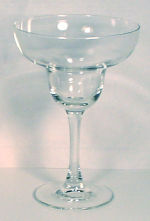
Snifter
A snifter — also called a balloon — is a type of stemware, a short-stemmed glass whose vessel has a wide bottom and a relatively narrow top. It is mostly used to serve aged brown spirits such as brandy and whisky...
to a tumbler.
The Consejo Regulador del Tequila (Tequila Regulatory Council) approved an "official tequila glass" in 2002 called the Ouverture Tequila glass, made by Riedel.
The margarita glass, frequently rimmed with salt or sugar, is a staple for the entire genre of tequila mixed drinks, including the margarita
Margarita
The margarita is a cocktail consisting of tequila mixed with orange-flavoured liqueur and lime or lemon juice, often served with salt on the glass rim. It is the most common tequila-based cocktail in the United States...
itself.
Other drinks
A large variety of drinks involve tequila. The most famous is the margarita, a cocktail that made tequila famous in the United States. The traditional margarita uses tequila, CointreauCointreau
Cointreau is a brand of triple sec produced in Saint-Barthélemy-d'Anjou, France. It is drunk as an apéritif and digestif, and is a component of several well-known cocktails. It was originally called "Curaçao Blanco Triple Sec".-Production:...
, and lime juice, though many variations exist. Most popular in Mexico is a drink called the Paloma
Paloma (cocktail)
The paloma is a tequila-based cocktail, most commonly prepared by mixing tequila with a grapefruit-flavored soda such as Squirt or Jarritos and served on the rocks with a lime wedge...
.
There are also a number of martini
Martini (cocktail)
The martini is a cocktail made with gin and vermouth, and garnished with an olive or a lemon twist. Over the years, the martini has become one of the best-known mixed alcoholic beverages. H. L. Mencken called the martini "the only American invention as perfect as the sonnet" and E. B...
variants that involve tequila, as well as a large number of tequila drinks made by adding a fruit juice. These include the Tequila Sunrise
Tequila Sunrise (cocktail)
The Tequila Sunrise is a cocktail made in two different ways, the original and the more popular concoction...
and the Matador
Matador (cocktail)
The Matador is a tequila-based cocktail. Less widely known than the margarita, its structure is similarly simple, with three primary ingredients: silver or blanco tequila, pineapple juice, and lime juice. Its chief coupling of pineapple and a single spirit resembles a Jackhammer, a variant of...
. Sodas and other carbonated drinks are a common mixer, as in the Tequila Slammer
Tequila Slammer
The Tequila Slammer is a cocktail served in a rocks glass...
.
External links
- National Chamber for the Tequila Industry
- Consejo Regulador del Tequila A.C.
- United States and Mexico Reach Agreement on Tequila (PDF)
- Tequila 101 - Mythos, History, Process (slideshow).

